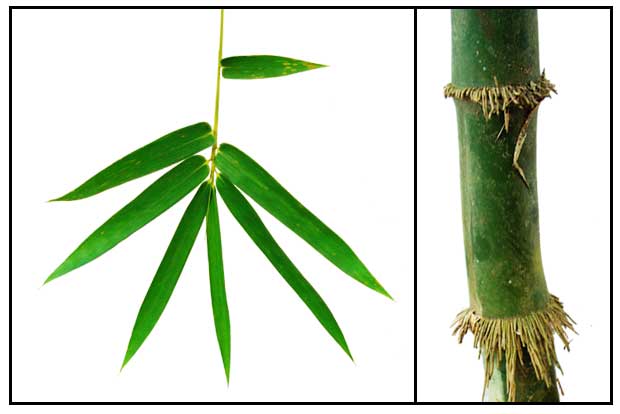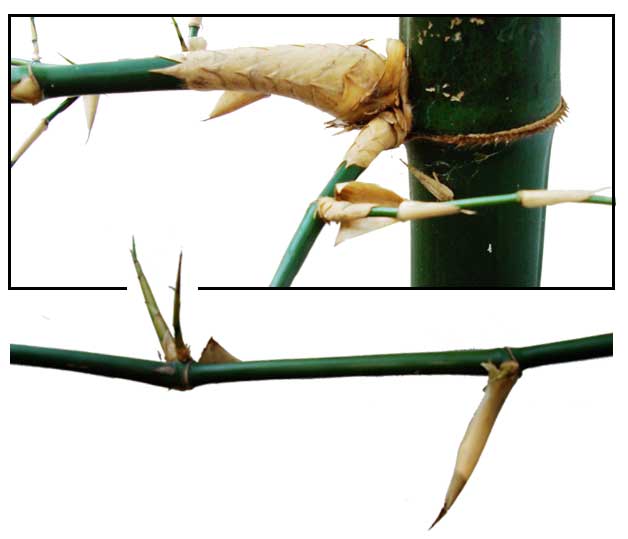 Botany Botany
Kauayan-kiling is an erect, loosely tufted plant. Stems are yellowish
or yellowish-green, up to 17 meters high, 15 centimeters in diameter, naked at
the base, without spiny branches. Leaves are lanceolate, up to 35 centimeters
long, 4 centimeters wide, often smaller. Spikelets are oblong, clustered along the branches
of the inflorescence, about 1.5 centimeters long. This species is smaller than
Bambusa spinosa and the culms have thinner walls.
Distribution
- At low and medium altitudes
in settled areas of most islands and provinces, from northern Luzon to Palawan and Mindanao.
- Probably introduced.
- Now pantropic in cultivation.
Constituents
- Rich source of natural silica.
- Bamboo shoots are rich in potassium, high in phenolic acids.
- Yields flavonoids, carbohydrates, glycosides, proteins and alkaloids.
- Petroleum ether extract of leaves yielded phytosterols and tannins.
(15)
- Leaf extract yielded carbohydrate, glycosides, alkaloids, flavonoids, phytosterols and triterpenoids
- Methanol extract yielded carbohydrates, tannins, phenols, saponins, flavonoids, volatile oils, steroids, and proteins.
(see study below) (16)
- Nutrient analysis
of aqueous extract of leaves yielded 10.75% moisture, 10.34% ash, 8.45% crude protein, 13.13% crude fat, 37.60% crude fiber and 19.73% carbohydrate content. Mineral analysis revealed generally high levels of Mg, Na, K, and Ca. (see study below) (18)
- Phytochemical screening of leaves yielded saponins, general glycosides, cyanogenic glycosides, and coumarins. (24)

Properties
- Abortifacient, antidiarrheal.
- Considered astringent, emmenagogue, vulnerary, febrifuge, antidiarrheal.
- Extracts yield antioxidant and vitamins.
- A rich source of flavone, phenolic acid, lactone and polyose.
- Studies have shown antibacterial, abortifacient, hypotensive, antimalarial, anti-inflammatory, antidiabetic, antifertility properties.
Parts utilized
Stems, roots, leaves.
Uses
Edibility / Nutrition
- The young shoots (labong) are also
edible as vegetables, but inferior to B. spinosa.
- In the Philippines, used for making achara.
Folkloric
- Decoction or infusion of roots used
for kidney problems.
- The aqueous sap of the plant used for phthisis.
- In Nigeria, reported use as abortifacient.
- In Indian folk medicine, used in the treatment of various inflammatory conditions.
- In India, leaves use for anti-fertility effects, extract taken orally to reduce sperm count. (21)
Others
- Construction / Paper: A variability study on strength and fiber properties of B. vulgaris showed a potential for using bamboo for the production of paper and as building and structural material. (19) Stems are used for building houses, furniture
and bridges, but inferior to B. spinosa.
- Cosmetics: Used as ingredient in skin care products. Also, as tooth polisher.
- Veterinary: In Trinidad and Tobago, dog owners use the leaves to treat diarrhea and control ectoparasites such as ticks and fleas. Studies
• Abortifacient / Leaves:
Study of aqueous extract of B. vulgaris leaves on pregnant Dutch rabbits substantiates abortifacient potential probably through changes in the implantation site, altered hormone levels and partly, estrogenicity. (1)
• Toxicological Studies:
No clinical signs of toxicity were observed in any of the animals during the study. The absence of overt toxicity such as increase in maternal deaths and clinical signs suggest the extract was not toxic when administered repeatedly to pregnant rabbits in the first 9 days of pregnancy. (2 )
• Hypotensive Effect:
Study in rabbits of macerated aqueous extract from sheets of B. vulgaris showed a hypotensive effect that was gradual, reversible and dose-dependent. (5)
• Antibacterial:
Methanolic extracts from air-dried plant material showed strong antimicrobial activity against S. epidermis and S. aureus. Among gram negative bacteria, maximum activity was observed on E. coli.
• Study showed B. vulgaris had antimicrobial activity on Gram-positive and Gram-negative bacteria. A methanolic extract inhibited the growth of multiple antibiotic resistance Staphylococcus aureus. (27)
• Antimalarial:
In a study of 30 species of plants belonging to 28 genera in 20 families, five, including Bambusa vulgaris, were documented for the first time for their use in the treatment of malaria. Study results provide basis
for further pharmacologic studies. (11) In-vitro study of 14 plant species used in Cuba showed two extracts, B. vulgaris and Punica granatum as active against P. falcifarum. (11)
• Anti-Inflammatory: Study of methanolic extract of B. vulgaris on rats and mice showed dose-dependent and significant inhibition of inflammation in all the experimental models. Phytochemical screening revealed flavonoids, carbohydrates, glycosides, proteins and alkaloids. There was no mortality in doses up to 2000 mg/kg p.o.
Phytochemical characterization of B vulgaris yielded triterpenoids, polar compounds with phenol free groups and fluorescent metabolites as major phytocompounds. (10)
• Pulp and Paper-making:
Study results showed that Bambusa vulgaris from Ghana
with fiber length of 2.65mm and Runkel Ratio of 1.03 is suitable for papermaking. (13)
• Phytochemicals / Acute Toxicity Study:
Phytochemical screening of a leaf extract of B. vulgaris yielded carbohydrate, glycosides, alkaloids, flavonoids, phytosterols and triterpenoids. Acute toxicity study on Swiss albino mice showed the extract to be safe till 2000 mg/kg oral dose, with no lethality of adverse toxic signs during the 14 days observation period. (14)
• Anti-Diabetic / Leaves / Toxicity Study:
Study evaluated the antidiabetic activity of petroleum ether extract of Bambusa vulgaris in streptozotocin induced diabetic rats. The extract was non-toxic up to 2000 mg/kbw dose. Results showed significant dose dependent lowering of fasting blood sugar comparable to standard drug Glibenclamide. (15)
• Antimicrobial / Leaves:
Study evaluated a methanol extract of leaves of B. vulgaris for antimicrobial activity . Maximum activity was found on B. subtilis among Gram-positive bacteria, and E. coli among Gram-negative bacteria. (see constituents above) (16)
• Anthelmintic / Leaves:
Study evaluated ethanolic and aqueous extracts of B. vulgaris leaf for anthelmintic activity in rabbits. The ethanolic extract appeared to be more potent in expelling ova of Ascaris worm. (17)
• Antimicrobial / Fortification:
Antimicrobial screening of bamboo leaf extract was active against Lactobacillus spp. Fortification with orange and pineapple juice enhanced the inhibitory effect against E. coli and Lactobacillus spp. (18)
• Potential Hepatotoxic / Leaves:
Study showed hepatotoxic concerns for the indiscriminate use of aqueous crude extract of B. vulgaris because of some toxic constituents that may cause overload of the endogenous biotransformation capacity of hepatic cells. (20)
• Antifertility
/ Effect on Sperm Count / Leaves: Study evaluated the sperm reducing potential of V. vulgaris leaf extract in male Wistar rats. Results showed 42% and 31% reduction in sperm count at 14 and 28 days, respectively, at 250 mg/kg dose, and 60% reduction at 500 mg/kg dose, with almost complete reversal of activity 12 days after cessation of treatment. (21)
• Wound Healing
/ Anti-Inflammatory / Leaves: Study evaluated the wound healing (incision and excision wound models) and anti-inflammatory carrageenan induced paw edema) potential of ethanol extract of B. vulgaris leaves in rats. Ethyl acetate and aqueous fractions in 5% w/w ointment formulation showed wound healing and anti-inflammatory activity as evidenced by inhibition of paw edema and acceleration of cutaneous wound healing. Antioxidant property was also seen as evidenced by increase in antioxidant levels. (22)
• Fodder: Study suggests the phytochemicals in bamboo leaves are not significantly (≥0.05) affected by air-drying and may be fed to livestock either in fresh state or in dry state as hay. The taxiphyllin isolated from bamboo shoots is likely the cyanogenic glycoside present in leaves but the deleterious effects on herbivores is not established. (see toxicity concerns below) (25)
• Bamboo as Eco-Friendly Roofing Material: Bamboo is a giant grass that can absorb more carbon dioxide in comparison to same-sized trees. Study of bamboo species in Ghana showed that B. vulgaris has the best properties for construction at four years of age and treatment will extend to last two years longer. Study suggests building with four year old bamboos and to use bamboo instead of wood or traditional bamboo roofs as alternatives to corrugated bamboo roofing sheets. (26)
• Larvicidal
/ Aedes aegypti / Leaves: Study evaluated the larvicidal effect of bamboo leaf extracts on Aedes aegypti. Statistically, (p≤1.000) there is no difference in efficacy among 50%, 75%, and 100% bamboo leaf extracts, while in control, all larvae developed into adult mosquitoes. (28)
Toxicity concerns
• Veterinary Toxicity:
Toxicity was reported on horses feeding on bamboo leaves during times of pasture scarcity. Neurological illness was associated with ingestion of large amounts of leaves of B. vulgaris f. vulgaris.
In the study, the disease showed no relationship to poisoning by hydrocyanic acid. Â (6)
• Taxiphyllin: Occurrence of taxiphyllin is a cyanogenic glycoside present in raw shoots and its harmful effect on human health calls for innovative processing to eliminate the toxic compound without alteration of its nutrient reserve. (23)
• Cyanogenic Glycosides: Cyanogenic glycosides are stored in inactive forms in plant vacuoles, becoming toxic when eaten by herbivores, with breakdown of cell membranes allowing the glycosides to come in contact with enzymes in the cytoplasm, releasing hydrogen cyanide which may block cellular respiration and lead to tissue damage. There are about 25 known cyanogenic glycosides from 2650 plant species, including amydalin (almonds), dhurrin (sorghum), linamarin (cassava, lima beans), prunasin (stone fruit) and taxiphyllin (bamboo shoots). Taxiphyllin isolated from bamboo shots is likely the cynogenic gycoside present in leaves. (24)
Availability
Cultivated or wildcrafted.
Extracts, oils and supplements in the cybermarket.
|


